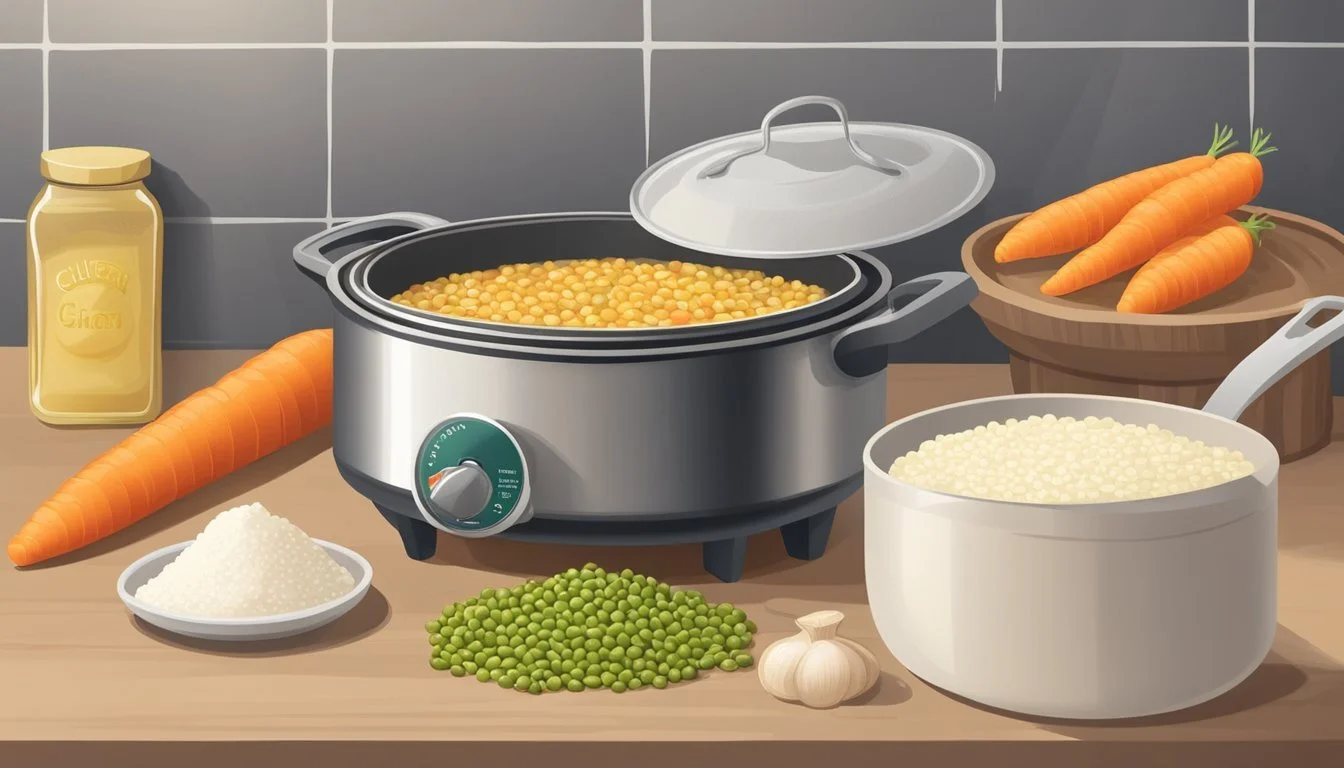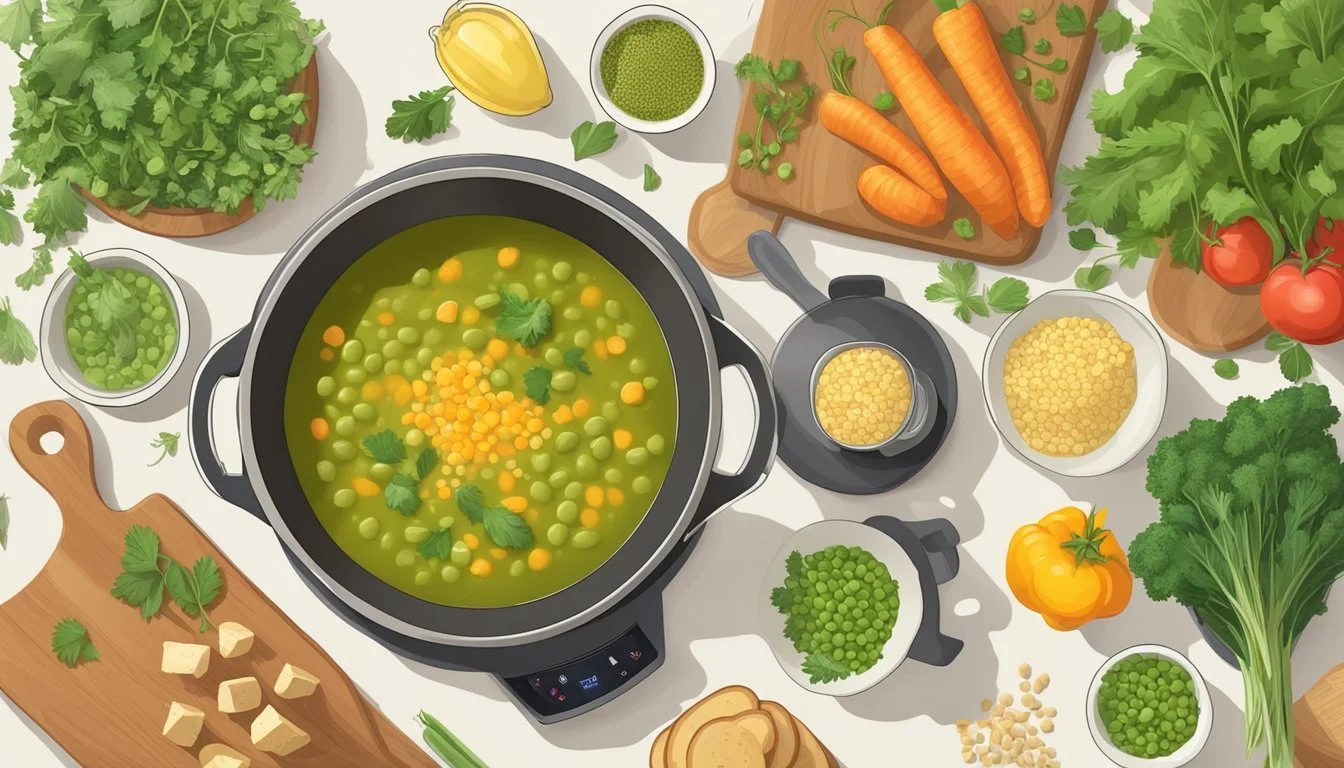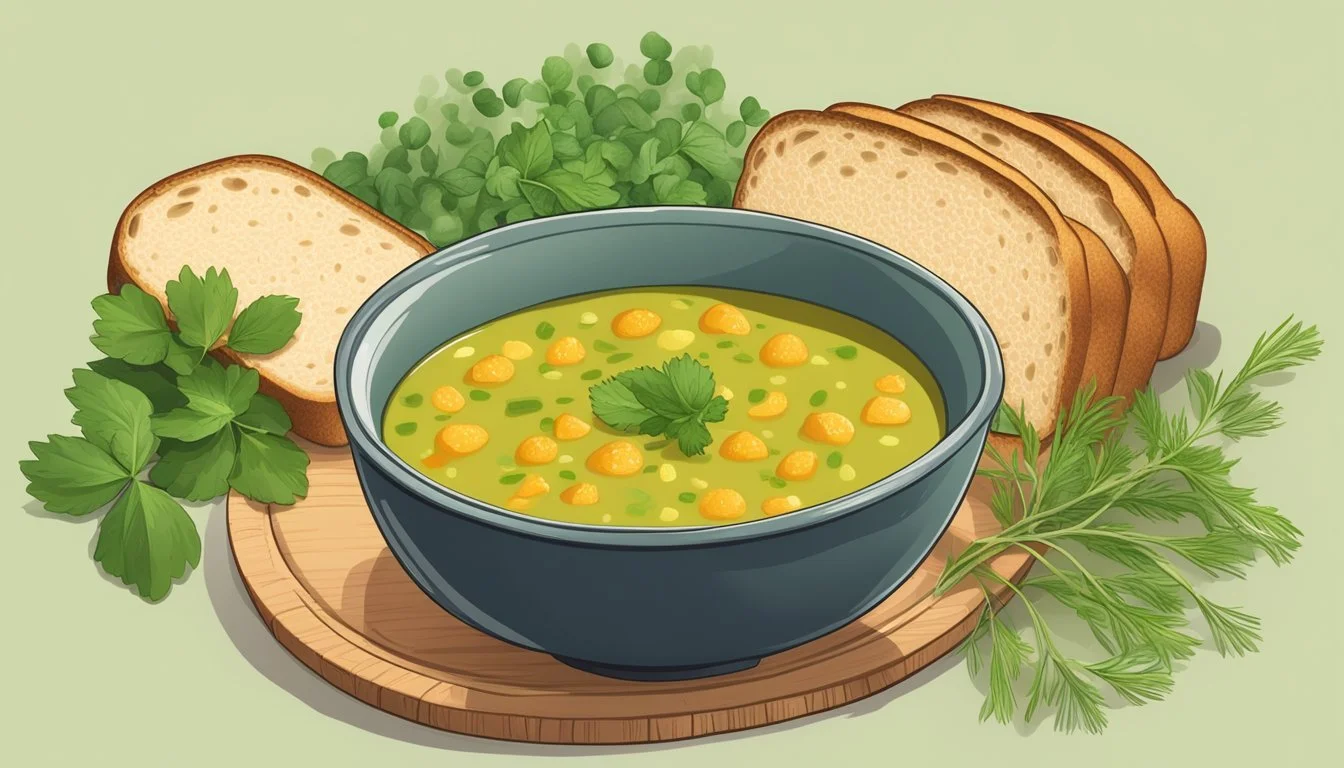Is Split Pea Soup Gluten-Free?
Determining Its Dietary Safety
Split pea soup is often known for its hearty texture and comforting qualities, making it a staple in many households, especially during colder months. The key ingredients in traditional split pea soup include dried split peas, vegetables, and sometimes ham or a ham bone for added flavor. For those with gluten sensitivities or celiac disease, the question of whether split pea soup is gluten-free is a crucial one.
Generally, split pea soup can be gluten-free, given that its main components—peas, vegetables, and meat—are free of gluten. However, the gluten-free status of the soup ultimately depends on the preparation and any additional ingredients. It is essential to ensure that no gluten-containing ingredients, such as certain broths, bouillon cubes, or seasonings, are used in the recipe.
Care must be taken when purchasing pre-made split pea soup or dining out, as cross-contamination can occur in kitchens where gluten-containing products are also handled. For those making split pea soup at home, checking ingredient labels for gluten or potential cross-contamination is important to ensure the soup remains a safe and enjoyable meal for those avoiding gluten.
What is Split Pea Soup?
Split Pea Soup is a traditional dish known for its thick, hearty consistency and savory flavor. It is typically made from dried peas, and its slow-cooked nature allows for a depth of flavor that's both comforting and nutritious.
Historical Background
Split Pea Soup has roots that extend hundreds of years, making it a staple in many cultures. The soup's simplicity and the widespread availability of its ingredients contributed to its longevity and popularity. It is often associated with frugal cooking, utilizing leftover ham bones from other meals.
Key Ingredients
Split Peas: The base of the soup, these are dried peas that have been split, which speeds up cooking.
Vegetables: Commonly includes carrots, celery, and onion, which provide essential flavor and nutrients.
Ham Bone: Often added to infuse the soup with a smoky flavor and is traditionally used up from leftovers.
Seasonings: Typically involves a mix of garlic, bay leaves, and other seasonings, contributing to the soup's distinct taste.
Olive Oil: Used for sautéeing the vegetables, contributing to the foundational flavors of the soup.
Most traditional recipes can be made gluten-free, considering that the primary ingredients such as peas, vegetables, and meat do not contain gluten. However, it is critical to ensure that any broth or stock used is also gluten-free.
Health Benefits of Split Pea Soup
Split Pea Soup offers a range of health benefits due to its rich nutritional profile and content. This makes it not only a comfort food but also a hearty choice for a balanced diet.
Nutritional Profile
Split Pea Soup typically contains a variety of essential nutrients. They include vitamins and minerals such as potassium, which contributes to maintaining normal blood pressure, and iron, which is crucial for oxygen transport in the body. The peas in the soup are also a good source of antioxidants, which protect against oxidative stress.
Nutrition Facts (per 1 cup cooked split peas):
Calories: Approximately 231
Carbohydrates: 41.2g
Fat: 0.8g
Protein: 16.3g
Dietary Fiber: 16.3g
Sugars: 5.7g
Iron: 2.5mg
Potassium: 710mg
Dietary Fiber and Protein Content
The dietary fiber in Split Pea Soup can be particularly beneficial for digestion and cardiovascular health. A high fiber diet is associated with a lower risk of heart disease and can help to regulate blood sugar levels by slowing down absorption. Specifically, Split Pea Soup can support blood cholesterol balance by reducing LDL (bad cholesterol) absorption.
Metrics:
Total Dietary Fiber: An impressive 16.3g, which contributes to feelings of fullness and aids in regular bowel movements.
Protein: With 16.3g per cup of cooked split peas, the soup is a robust source of plant-based protein, essential for the body's repair and maintenance.
Identifying Gluten in Soup Recipes
Identifying gluten in soup recipes is crucial for those adhering to a gluten-free diet. Soup often consists of broth, seasoning, and spices, which can be sources of hidden gluten. Understanding which ingredients commonly contain gluten and which alternatives are safe is key to preparing a gluten-free soup.
Common Gluten Containing Ingredients
Certain ingredients are often found in soup recipes that may contain gluten. These include:
Broth: Some broths are thickened with ingredients derived from wheat. Always check the label.
Seasoning and Spices: Premade spice blends can have wheat-based additives for flavor or as anti-caking agents.
Thickeners: Ingredients like flour or certain starches used to thicken soups (What wine goes well with soups?) can be derived from wheat.
Processed Ingredients: Items like smoked paprika could be cross-contaminated with gluten during processing unless labeled gluten-free.
Safe Gluten-Free Alternatives
When creating a gluten-free soup recipe, it's important to use ingredients that are inherently free from gluten. These alternatives include:
Broth: Use homemade broths or purchase brands that are certified gluten-free.
Spices and Seasoning: Opt for pure spices rather than blends and confirm with the manufacturer if needed.
Thickeners: Arrowroot, cornstarch, and gluten-free flours are safe options for thickening soups.
Certified Gluten-Free Ingredients: Ensure that any packaged items, like smoked paprika, are labeled as gluten-free to avoid cross-contamination.
Preparing Split Pea Soup
Before embarking on the journey of preparing split pea soup, one must be aware that the key to a successful dish lies in correctly cooking the peas and achieving the right texture.
Steps for Cooking Split Pea Soup
The process begins with rinsing the green split peas fully and, if time allows, soaking them in hot water for about 10 minutes to expedite cooking. One starts by heating olive oil in a large stockpot and sautéing onions until they become soft and translucent. To this base, one adds diced carrots, potatoes, and smoked ham, creating a rich and flavorful foundation.
The critical steps include:
Combining Ingredients: Add rinsed split peas, any additional vegetables like carrots or potatoes, smoked ham for depth of flavor, seasonings like bay leaves, and sufficient water into the stockpot.
Initial Boil: Bring the mixture to a boil and make sure to give it a good stir to integrate all the ingredients.
Simmering: Once boiling, reduce heat to a low setting to let the soup simmer. It should be cooked until the peas are tender and the soup has thickened, which often takes around 1 hour.
Blending (Optional): For a smoother consistency, using an immersion blender directly in the pot or transferring portions of the soup to a food processor achieves a creamy texture.
Tips for Achieving the Perfect Consistency
Simmering is a crucial technique in making split pea soup as it gently cooks the peas until they become perfectly tender. Over the simmering period, the starches within the peas break down which naturally thickens the soup. The desired thickness is a personal preference, but it is commonly favored with a viscosity that allows the spoon to stand.
Key tips include:
Stirring Occasionally: This prevents sticking and ensures even cooking. It is important to stay attentive, especially as the soup thickens.
Water to Pea Ratio: Adjust the amount of liquid based on desired thickness. More water can be added for a thinner consistency.
Immersion Blender/Food Processor Use: For achieving a smoother texture, blend the soup to preference, and add additional liquid if it becomes too thick after blending.
By following these specific steps and tips, one can reliably produce a comforting bowl of gluten-free split pea soup.
Customizing Split Pea Soup
When customizing split pea soup, the possibilities are plentiful whether tailoring it for vegetarians and vegans or enriching its flavor profile. Cooks can opt for various ingredients to align with dietary preferences or to simply elevate the dish's depth of taste.
Vegetarian and Vegan Variations
To adapt split pea soup for vegetarian or vegan diets, one can replace traditional smoked ham hocks with alternatives like liquid smoke for the smokiness, or add more vegetables like carrots, potatoes, and aromatic leeks or green onions. Vegan variations specifically exclude any animal products, which means substituting any meat or meat-based broths with vegetable broth and ensuring that any accompanying bread is also vegan.
Additional Ingredients for Enhanced Flavor
Incorporating additional ingredients can take split pea soup from good to great in terms of flavor. Cooks might add parsley, a bay leaf, and cumin to introduce more intricate layers to the soup's aroma. For those not adhering to vegetarian or vegan diets, the addition of smoked ham hocks can provide a robust, savory quality reminiscent of traditional ham and potato soup.
Serving and Accompaniments
Selecting the right sides and garnishes is essential for enhancing the flavor and texture of gluten-free split pea soup. Accompaniments should complement the hearty, savory taste of the soup without overwhelming it.
Recommended Sides and Toppings
Split pea soup is often enjoyed with a variety of sides and toppings that can add texture and flavor to the dish. Here are some specific recommendations:
Bread: Serve with slices of crusty gluten-free bread or gluten-free croutons for added crunch.
Salads: A fresh garden salad or a simple spring mix can bring a lightness to balance the soup's richness.
Sour Cream: A dollop of sour cream on top of the soup can introduce a creamy element and a tangy flavor.
In terms of toppings, chopped green onion or parsley can be sprinkled on top to add a fresh pop of color and a mild, herby taste. Adding a squeeze of lemon juice not only enhances the flavors with a slight tartness but can also brighten the overall taste of the soup.
Presentation and Garnishing Tips
The presentation of split pea soup should be simple yet appealing, drawing the diner's focus to the comforting qualities of the dish.
Garnishing:
Sprinkle finely chopped parsley or green onion on top of the soup just before serving.
A lemon wedge on the side of the bowl allows diners to adjust the acidity to their liking.
By carefully selecting sides that complement the split pea soup and presenting it with simple, attractive garnishes, the dish can be elevated to a full and satisfying meal.
Storing and Reheating
Proper storage and reheating methods ensure the longevity and quality of split pea soup. Whether one uses leftover ham, homemade broth, or water, applying these techniques will help maintain the soup's flavor and texture.
How to Properly Freeze and Thaw
To preserve split pea soup, cool the soup completely before storage. Transfer it to a freezer-safe container, leaving enough room to accommodate expansion as it freezes. It can then be stored in the freezer where typically, split pea soup will remain good for 4-6 months.
When one is ready to enjoy the soup again, thawing it in the refrigerator overnight is advisable. This slower defrosting process helps ensure even reheating later and preserves the quality of the ingredients, especially if the soup contains chunks of leftover ham or vegetables.
Reheating for Best Quality
For reheating, split pea soup fares best when slowly brought up to temperature on the stovetop or heated in the microwave. If using a stovetop, transfer the thawed soup into a pot and warm it over medium heat, stirring occasionally to prevent sticking and ensure even warming throughout. If there's leftover ham in the soup, additional care should be taken to ensure it reaches a safe temperature.
In the case of microwaving, place the soup in a microwave-safe dish, ideally covering it with a lid or microwave-safe wrap to avoid splattering. Stirring the soup halfway through the reheating process will help distribute heat evenly. Regardless of the method, one should heat the soup until it reaches an internal temperature of 165°F to ensure food safety.
Common Questions and Myths
Navigating the world of gluten-free diets can be challenging, and misconceptions often arise concerning foods like split pea soup. This section tackles prevalent myths and answers common questions to provide clarity on whether split pea soup is gluten-free.
Debunking Myths about Split Pea Soup
Myth #1: All split pea soup is gluten-free by nature.
Fact: While split peas themselves do not contain gluten, it's crucial to be wary of additional ingredients or thickening agents like flour that can be added to the soup, which would introduce gluten.
Myth #2: Soups labeled "natural" or "organic" are definitely gluten-free.
Fact: These labels do not guarantee that the soup is free of gluten. One must still inspect the ingredients list or contact the manufacturer to confirm its gluten-free status.
FAQs Relating to Gluten and Split Pea Soup
Is homemade split pea soup gluten-free?
Homemade split pea soup can be gluten-free if all the ingredients used, including the broth, do not contain gluten. Common vegetables such as celery, carrot, and onion used in making split pea soup are naturally gluten-free.Can I enjoy split pea soup with ham if I'm on a gluten-free diet?
Yes, but one should ensure that the ham used is labeled gluten-free since processed meats like ham, especially smoked ham commonly enjoyed around Easter, might contain gluten-containing additives.How can I verify if store-bought split pea soup is safe to eat on a gluten-free diet?
Always check the label for a gluten-free certification or for any mention of gluten-containing ingredients. When in doubt, contact the manufacturer directly.
Conclusion
In assessing the gluten-free status of split pea soup, it is essential to recognize that split peas, as legumes, are inherently gluten-free. They offer a robust source of protein while being low in calories, fat, and cholesterol—attributes making them suitable for a health-conscious diet.
When preparing split pea soup, one must diligently ensure that all added ingredients are also gluten-free. This entails using gluten-free flour if crafting a roux or verifying that any stock or broth employed does not contain gluten. The culinary practice of browning flour to create a roux often introduces a point of gluten cross-contamination; however, by opting for gluten-free flour and maintaining rigorous adherence to gluten-free practices, the soup can be safely enjoyed by those with celiac disease or gluten sensitivity.
Consumers purchasing prepackaged pea soup or dining out should examine labels and inquire with manufacturers or chefs to confirm the absence of gluten-containing ingredients. As with any dietary requirement, vigilance is key to maintaining health and preventing adverse reactions.
In summary, split pea soup can be a nourishing and gluten-free choice when carefully prepared or selected. To maintain its gluten-free integrity, attention must be paid to the individual ingredients and their preparation methods.









